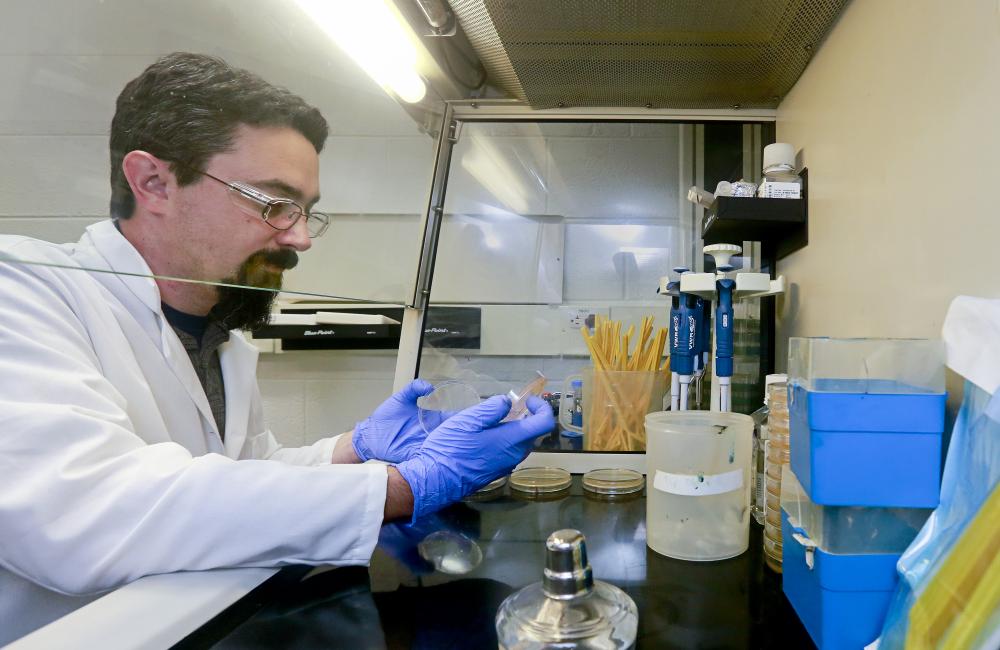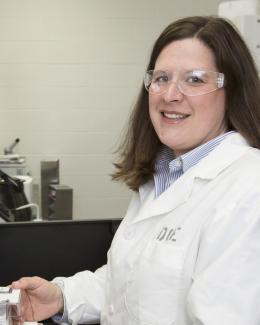ORNL’s Adam Guss is part of a research team that optimized the Pseudomonas putida bacterium to simultaneously digest five of the most abundant components of lignocellulosic biomass. Credit: Jason Richards/ORNL, U.S. Dept. of Energy
Oak Ridge National Laboratory scientists have modified a single microbe to simultaneously digest five of the most abundant components of lignocellulosic biomass, a big step forward in the development of a cost-effective biochemical conversion process to turn plants into renewable fuels and chemicals.
The team engineered the Pseudomonas putida bacterium to consume glucose, xylose, arabinose, coumaric acid and acetic acid in a single bioreactor, eliminating the need for multiple tanks and microbes for each of those components. The one-pot process also breaks down lignin — traditionally a waste product of biomass conversion — so that every part of the plant can be used to create valuable products.
“We were pleasantly surprised at how quickly and well the microbe consumed these components, as they are structurally different and utilized via very different pathways,” said Adam Guss, who led ORNL’s research as detailed in Metabolic Engineering. “You had all of this carbon converging in the central metabolism and being co-utilized. It was pretty exciting.”
Upgrading lignin as well as sugars from biomass is vital to creating a highly efficient, cost-effective biorefinery. To reach that goal, lignin, which accounts for about 10%-30% of lignocellulose biomass by weight and represents up to 40% of total carbon, must be converted to value-added products to increase yield and reduce the cost of the overall bioconversion process.
ORNL scientists took P. putida, a hardy microorganism efficient at digesting glucose, coumarate and acetate, and optimized pathways for digesting those compounds, as well as xylose and arabinose. One of the major challenges in synthetic biology is to get an organism to co-utilize multiple compounds. The researchers used rational metabolic engineering, evolution and reverse engineering to cultivate these desired traits in the microbe.
The engineered microbe was then tested in a bioreactor on corn stover-derived biomass by project partners at the National Renewable Energy Laboratory as part of the Agile BioFoundry, a Department of Energy consortium that brings together the expertise and capabilities of nine national labs to advance state-of-the-art biomanufacturing.
The accomplishment also overcomes the problem of trying to use more than one microorganism in a single process bioreactor. “It’s hard to engineer two organisms that like the exact same conditions and play well with each other,” Guss said. “Using a single, optimized organism eliminates a lot of those challenges.”
Next steps in the work include further expansion of the number of substrates that P. putida can digest and gaining a better understanding of how these different pathways interact with each other to make the overall process as efficient as possible, Guss noted.
This study builds on a rich legacy of metabolic engineering at ORNL, part of its research that spans the spectrum from the development of hardy biomass crops, multifunctional microbes and other processes to valorize plant components to create clean, domestic, sustainably sourced fuels and chemicals that can support rural economies.
“We’re still in the early stages of making commercially viable processes that turn biomass into fuels and chemicals, and one of the big goals is the reducing the cost of breaking down biomass into individual components,” Guss said. “With this technology, you won’t need multiple tanks — one doing fermentation and sugar conversion, another doing aromatics and another doing acetate, for instance. Instead it can all be done together.”
The project was supported by DOE’s Office of Energy Efficiency and Renewable Energy’s Bioenergy Technologies Office, and by ORNL’s Laboratory Directed Research and Development Program.
ORNL is managed by UT-Battelle for the U.S. Department of Energy's Office of Science, the single largest supporter of basic research in the physical sciences in the United States. DOE’s Office of Science is working to address some of the most pressing challenges of our time. For more information, please visit https://energy.gov/science.





